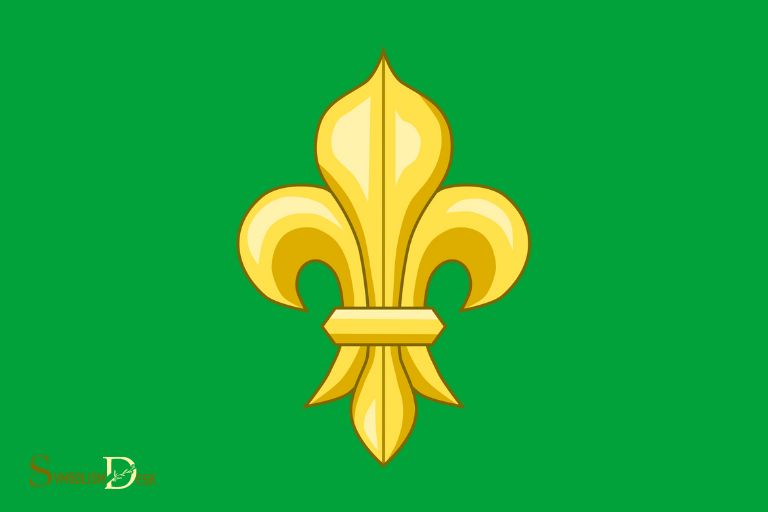Name of the Saints Symbol: Fleur-de-Lis!
The name of the saints symbol is the Fleur-de-Lis.
The Fleur-de-Lis is a stylized lily or iris that has been used as a decorative design and a symbol of French royal families, Christian saints, and various religious, political, and cultural organizations throughout history.
The name “Fleur-de-Lis” translates from French to “lily flower” or “flower of the lily.” In the Christian context, it is often associated with the Virgin Mary, the Holy Trinity, and saints – particularly Saint Louis, Saint Joseph, and Saint Joan of Arc.
The Fleur-de-Lis has been a powerful symbol throughout history, representing not only the French royalty but also the sanctity and purity of Christian faith.
Its use in art, architecture, and heraldry showcases the deep connection between the symbol and its multifaceted meanings.
With its enduring presence, the Fleur-de-Lis continues to be an iconic emblem of spirituality, nobility, and cultural heritage. It has been used in various coats of arms, flags, and emblems throughout history, symbolizing a sense of pride and honor. The Fleur-de-Lis has also been adopted by different religious and cultural groups, further solidifying its significance as a representation of unity and tradition. In fact, the Fleur-de-Lis is often seen as a symbol of the Holy Trinity in Christianity, and its three petals have been interpreted as representing faith, wisdom, and chivalry. In mathematical terms, the Fleur-de-Lis has even been associated with the division symbol obelus meaning ‘inverted sickle’, adding to its diverse and rich symbolism.
34 Name of the Saints Symbol Chart
| Saint Name | Symbol |
|---|---|
| St. Peter | Keys |
| St. Paul | Sword & Book |
| St. Andrew | Saltire Cross |
| St. James the Greater | Scallop Shell & Pilgrim’s Staff |
| St. John the Evangelist | Eagle & Chalice |
| St. Thomas | Carpenter’s Square & Spear |
| St. James the Less | Fuller’s Club & Book |
| St. Philip | Latin Cross & Basket |
| St. Bartholomew | Knife & Flayed Skin |
| St. Matthew | Three Money Bags & Halberd |
| St. Simon | Saw & Book |
| St. Jude Thaddeus | Square Rule & Ship |
| St. Matthias | Halberd & Book |
| St. Stephen | Palm Branch & Stone |
| St. Lawrence | Gridiron & Palm Branch |
| St. Agnes | Lamb & Palm Branch |
| St. Cecilia | Organ & Palm Branch |
| St. Christopher | Staff & Christ Child |
| St. George | Shield, Spear & Dragon |
| St. Sebastian | Arrows & Tree Stump |
| St. Lucy | Eyes on a Dish & Palm Branch |
| St. Catherine of Alexandria | Wheel & Sword |
| St. Patrick | Shamrock & Snake |
| St. Francis of Assisi | Birds & Stigmata |
| St. Clare of Assisi | Monstrance & Palm Branch |
| St. Anthony of Padua | Christ Child & Bread |
| St. Therese of Lisieux | Roses & Crucifix |
| St. Joseph | Lily & Carpenter’s Square |
| St. Christopher | Staff & Christ Child |
| St. Benedict | Cross & Book |
| St. Dominic | Rosary & Dog with Torch |
| St. Ignatius of Loyola | Heart with “IHS” & Book |
| St. Teresa of Avila | Quill & Ecstasy of St. Teresa |
| St. John of the Cross | Quill & Dark Night of the Soul |
Key Takeaway

Five Facts About the Name Of The Saints Symbol
The Historical Significance Of the Name Of The Saints Symbol
Name of the saints symbol is an emblematic visual representation of the saints often depicted in christian icons, literature, and art.
The symbol aims to encapsulate the key attributes and virtues of the saint and serve as a reminder of their lives, teachings, and miracles.
Introduction To The Origins Of Name Of The Saints Symbol
The origin of name of the saints symbol dates back to the early days of the christian church.
The symbol was first introduced to the faithful as a way of communicating the life and teachings of the saint without the need for verbal communication, especially in regions where language barriers existed.
The name of the saints symbol was designed to be visually recognizable, easy to understand, and to contain meaningful symbolism that would give the viewer an insight into the saint’s life.
Historical Importance Of Name Of The Saints Symbol In Christian Culture
The name of the saints symbol has great historical and cultural significance in christianity. It serves as a way of celebrating and commemorating the saint’s life, mission, and legacy, and has been used extensively in christian art, literature, and music.
For centuries, the name of the saints symbol has inspired faith, devotion, and awe and has played a significant role in the faith formation of christians worldwide.
Examples Of How Name Of The Saints Symbol Has Been Used Throughout History
The name of the saints symbol has been used in a variety of ways and contexts throughout history.
Here are some examples:
Name of the saints symbol has been an essential part of christianity since its inception. The symbol has played a critical role in communicating the life and teachings of the saints to christians worldwide.
Its use in various forms of art, literature, and holy places serves as a reminder of the saint’s legacy and encourages the faithful to follow in their footsteps.
Understanding The Symbolism Of Name Of The Saints Symbol
Name of the saints symbol is one of the most recognizable symbols in christianity. This iconography is known for its unique design and its symbolic representation of different elements related to the saints.
Understanding the symbolism of name of the saints symbol is essential for christians who use this symbol for various religious and cultural activities.
We will explore the meaning behind the iconography of name of the saints symbol, the symbolism of individual elements, and the relevance of this symbol in the modern world.
Meaning Behind The Iconography Of Name Of The Saints Symbol
Symbolism Of Individual Elements In Name Of The Saints Symbol
Relevance Of Name Of The Saints Symbol In The Modern World
- The name of the saints symbol is an essential part of christian tradition and culture, used in churches, art, and rituals, such as baptism, weddings, and funerals.
- This symbol also serves as a reminder of the central message of christianity, which is the death and resurrection of jesus and his sacrifice for humanity.
- The name of the saints symbol has also become a recognizable symbol in pop culture, used in various merchandise, logos, and designs.
The name of the saints symbol is a significant iconography in christianity, reminding people of the message of salvation and hope that jesus brought.
Its unique design and symbolic representation make it an essential part of christian tradition and culture, as well as a recognizable symbol in modern society.
Whether it’s used in religious or secular contexts, the name of the saints symbol continues to inspire and uplift people worldwide.
The Role Of Name Of The Saints Symbol In Catholicism
The name of the saints symbol has a significant role in catholic culture. This symbol is an important part of catholic religious practice, with historical significance that dates back centuries.
Here are some key points about the role of the name of the saints symbol in catholicism:
Introduction To Name Of The Saints Symbol In Catholic Culture
- The name of the saints symbol is a representation of the patron saint who is the protector of a particular group, community, or individual.
- This symbol is commonly used in catholic churches, artwork, literature, and other forms of religious practice.
How Name Of The Saints Symbol Is Used In Catholic Religious Practice
- The name of the saints symbol is often used in prayer, as catholics believe that invoking the patron saint’s name can provide guidance, protection, and strength.
- The symbol may also be used in the naming of churches, schools, hospitals, and other institutions to signify their affiliation with a particular patron or saint.
Historical Significance Of Name Of The Saints Symbol In The Catholic Church
- The use of patron saints dates back to the early centuries of christianity, when converts were often assigned a patron saint to protect and guide them.
- During the middle ages, the patron saint was often the community’s primary focus, and the name of the saints symbol became an important part of religious art and literature.
- Today, the name of the saints symbol continues to play a significant role in catholic religious practice, with many communities and individuals still seeking guidance and protection from their patron saint.
The name of the saints symbol is an important part of catholic culture, with a rich historical significance.
It is used in many aspects of religious practice, and remains an important symbol of guidance and protection for catholics around the world.
Artistic Representations Of Name Of The Saints Symbol
Name of the saints symbol is a powerful representation of the values and virtues associated with particular saints.
Over the years, different artists have produced a wealth of artistic representations of name of the saints symbol, often in strikingly varied ways.
Here, we take a closer look at historical, aesthetic, and contemporary examples of name of the saints symbol in art.
Historical Examples Of Name Of The Saints Symbol In Art
- During the medieval and renaissance periods, artists frequently depicted name of the saints symbol in a highly stylized manner. They often used iconography to convey religious or spiritual messages to viewers.
- Many of these works of art showcased rich, vibrant colors and intricate designs that depict the different attributes of the saints’ symbols.
- One popular piece from this period is the painting of st. francis of assisi, which typically features his symbol of a bird. In these artworks, the bird is often shown sitting on st. francis’ hand or shoulder, representing his connection with nature.
How Different Artists Have Approached The Iconography Of Name Of The Saints Symbol
- Iconography of name of the saints symbol has been interpreted in considerably different ways by various artists.
- Some artists create hyper-realistic renditions that emphasize the object’s naturalistic features, such as the physical characteristics of the bird in st. francis of assisi’s case.
- Others used more abstract approaches, where they focused on capturing the symbolic meanings associated with the object of the saint’s symbol rather than its actual appearance.
- A few artists even took a more comical approach to their art, producing irreverent images such as the hilarious depiction of st. catherine of siena riding on a giant snail, which is her symbol.
Contemporary Examples Of Name Of The Saints Symbol In Artistic Contexts
- In contemporary art, artists have explored new methods of representation for name of the saints symbol.
- Some artists have opted to create digital renderings of the symbols or using mixed media to achieve a unique effect.
- Additionally, modern artists often blend traditional iconography of name of the saints symbol with their unique personal styles, creating spectacular scenes filled with contrasts and contradictions.
- For example, some contemporary artworks have merged old and new styles of art to depict the symbolism of st. john the evangelist’s eagle in a fresh and innovative way.
For centuries, name of the saints symbol has been a crucial aspect of countless artworks. From renaissance masterpieces to contemporary digital renderings, artists have explored countless different ways to represent these symbols.
The constant renewal of these symbols in art testifies to their enduring power and influence over artists today.
Is the “At Sign” Symbol Related to the Fleur-de-Lis Symbol in any Way?
The english symbol: at sign explanation has no direct relation to the Fleur-de-Lis symbol. The at sign is commonly used in email addresses and emerged from a medieval abbreviation for at the rate of. On the other hand, the Fleur-de-Lis symbol holds historical significance representing various meanings across different cultures, often associated with royalty and purity.
FAQ On Name Of The Saints Symbol
What Is The Saint Symbol?
A saint symbol is an emblem that represents a saint.
What Are The Most Popular Saint Symbols?
The most popular saint symbols are st. george’s cross, st. christopher’s medal, and our lady of guadalupe.
What Is The Symbol For St. Michael?
St. michael is represented by a sword, armor, and a shield.
What Is The Symbol For St. Jude?
St. jude’s symbol is a flame, which represents his role as one of the apostles.
What Is The Symbol For St. Agatha?
St. agatha is often shown carrying her breasts on a platter, as she was martyred by having her breasts cut off.
Conclusion
As we wrap up this blog post on the name of the saints symbol, we can take away the importance of symbols in religious contexts. The symbols associated with the saints can tell us a lot about their lives and the virtues they upheld.
Whether it’s st. patrick’s shamrock or st. catherine’s wheel, each symbol is unique and carries significant meaning. As christians, it’s vital to understand the significance of these symbols in our religious practices.
Additionally, understanding the life and teachings of the saints is an inspiration for leading a more virtuous life.
At the same time, these symbols also serve as a reminder of the importance of faith and devotion in our lives. As we continue to learn about the traditions and symbols associated with our religious beliefs, we strengthen our faith and appreciation for our faith’s customs.






